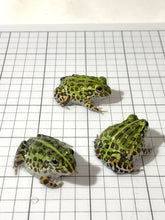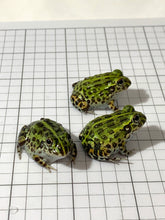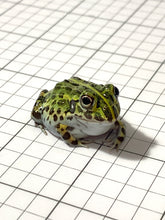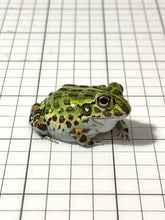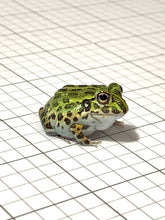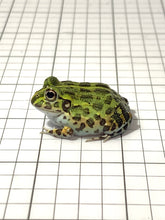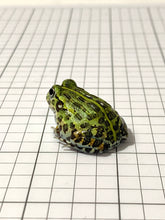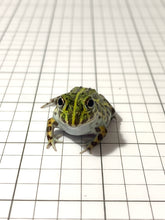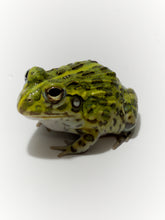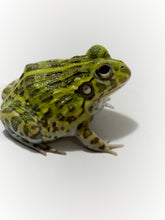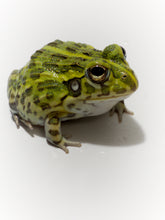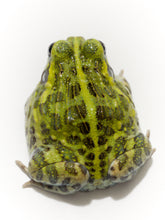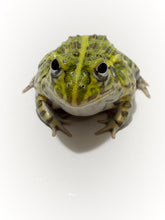
Highlights:
- Easy to keep
- One of the largest Frog species
- Aggressive
- Low rumbling call
- Very Large
- Solitary (May be housed together give enough space and food. Frogs that are housed together must be similar size.
Name: The scientific name of the Giant Pixie frog is Pyxicephalus adspersus. Pyxicephalus roughly translates into "small head" which is an apt description for this genus of frogs. Common names include Pixy Frog and the Giant African Bullfrog.
Recommended Enclosure Size: We recommend at least a 20 gallon long for adults. Coco fiber is a good substrate for these frogs. A large water bowl is definitely required for this species. Large hides or cork flats tend to work really well for shelter as plants will just get trampled on.
Temperature: They can take much higher temperatures than other frogs but are most comfortable in the mid to high 70s. If it gets too hot they will attempt to enter dormancy and bury themselves and stop eating.
Humidity: Much like temperature Pixie Frogs can take some pretty low humidity levels but prefer to stay in 50-60% range. Low humidity levels paired with warmer than normal temperatures can also trigger dormancy which isn't necessary unless breeding is being attempted.
Size: Pixie frogs will be at least 1" long at time of sale but may be larger as they grow rapidly. Males can reach 10" and females just 5.5." Males use their impressive size in combat with each other during the mating season.
Age: These frogs have been known to live for up to 15 years but may live longer with ideal care. Frogs sold by us are about 2-3 months out of the water.
Feeding: This list includes: Crickets, Roaches, Nightcrawlers, Hornworms, Frozen/Thawed Mice, Black Soldier Fly Larvae, butter worms, and Super worms. As a rule of thumb frogs should not be fed anything that is larger than the space between the eyes.
Sexing: Sexing these frogs as adults is very easy as there is very little size overlap with the males and females. Females will be very rotund and seem to have no neck where males will be more elongated and have orange patches in the armpits. Young frogs have a darker green coloration with some
Color/Pattern: Pixie frogs as adults are a dark olive green and white/cream on the ventral side. Males have a band of yellow or orange separating these colors. Young frogs have lighter green interspersed between the olive coloration; this goes away over time.
Social Behavior: They are very food aggressive and can do significant damage to each other it is for this reason we recommend housing them separately.
Breeding: Breeding Pixie frogs in captivity is very difficult and hit or miss most of the time. A dry hot period is required for a set period of time that can vary from 4-10 months in the wild. During this time the frogs will create a skin cocoon around themselves to retain moisture. They shed this cocoon during heavy rains and make their way to pools of water where the males will throw each other around to win over the females nearby. Females can lay up to 4,000 eggs at a time.
Natural Range: This species occurs widely in South Africa, Swaziland, Namibia, Botswana, and Zimbabwe, extending north to southern Angola, Zambia, Malawi, Mozambique, Tanzania, and Kenya. Its distribution needs re-examination in light of recent separation of Pyxicephalus edulus from P. adspersus. Many specimens have not been clearly assigned between these two species. It is presumed to occur in southern Democratic Republic of Congo, but there have not been any confirmed records from this country.
History in the Hobby: This frog species has long been desired for its impressive size and voracious appetite. Captive bred individuals are usually available but in the past the majority of frogs were wild caught adults.














